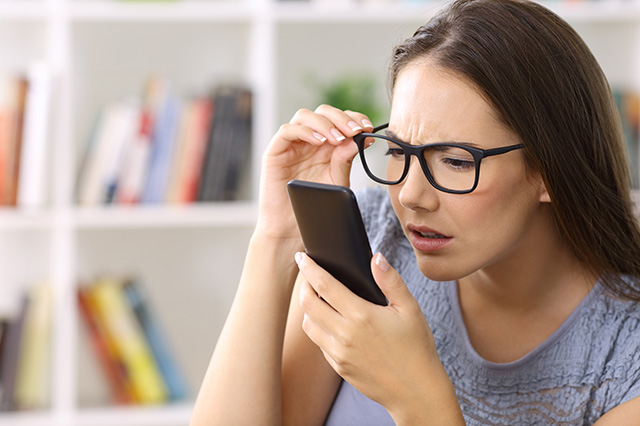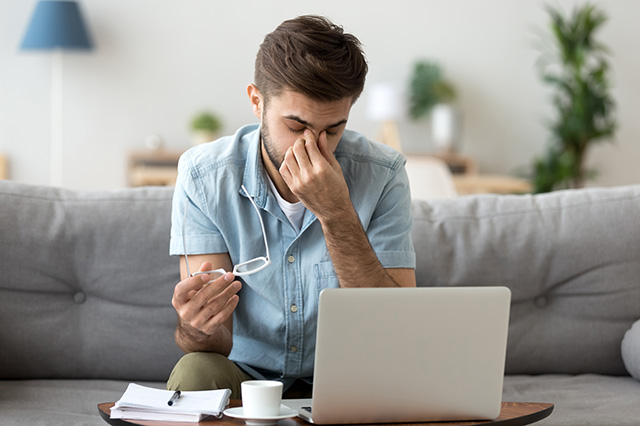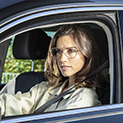Between time spent working on the computer, using smartphones, streaming the latest television flick phenomenon and relishing the latest best-selling e-book, we spend a lot of time staring at screens; in fact, 60% of American adults spend at least six hours per day on a digital device. All that screen time is taking a toll on our health; namely, on our eyesight.
Digital eye strain is defined by adverse physical symptoms that occur when regularly using digital devices such as computers, smartphones, e-readers and even watching television or playing video games. Such symptoms can include blurred vision, squinting, dry eyes, increased rigidity in the shoulders, neck and back, and headaches.
But 70% of adults who regularly use their devices and have encountered digital eye strain don’t even know what is causing their symptoms, so they don’t do anything about it.
If you suspect you’re experiencing digital eye strain, here are 10 things you can do.
- Whether you’re at work or on your home computer, be sure to assemble a healthy work area. Your face should be close enough to the screen (about two feet away) so that you can see clearly. Make sure your chair offers proper support for good posture to help ease any back, shoulder or neck pain.
- Don’t position your screen off to the side; look at it head on and make sure your computer screen sits slightly below eye level. Prop your monitor or laptop up with a book or other item if needed.
- Use indirect lighting; Overhead lighting challenges screen light and forces your eyes to concentrate harder to see. Turn off the overhead light in your office and invest in a nice little side table lamp. The lighting will offer calmer ambiance as well as assisting with your eyesight.
- Play with the settings on your device. Increase the text size in your text messages. Adapt the brightness on your phone or computer to the level that is most comfortable for you and your individual eyesight needs and to the level where you can see the best and your eyes are the most comfortable. The color temperature settings can also cut down on blue light emissions. Your friends might poke fun at you for your massive text message font, but you won’t be complaining about blurriness.
- A common symptom of digital eye strain is eye dryness, which is caused in part by the fact that we blink one half to one third less when using a digital device. Therefore, be mindful of blinking and be sure to stay hydrated by drinking plenty of water. If you find your eyes getting too dry, use artificial tears.

- Look away once in a while! Adopt a 20-20-20 habit. Every twenty minutes, look away from the screen at something about 20 feet away. This will help refocus your eyes and give them a break from the blue light emissions.
- Get an annual eye exam and be honest with your doctor about how much time you spend in front of digital devices. Your doctor is a professional who can assess your symptoms and recommend lenses or habit changes that can help mitigate symptoms and help prevent future damage. Use them as a resource! Stop into your local LensCrafters, where AAA members get 30% off at participating locations.
- Get blue light blocking glasses to help reduce the amount of blue light reaching your retinas and the resulting headaches. Blue light occurs naturally and helps to control our sleep cycles as well as elevating attentiveness and general state of mind; however, artificial blue light – the kind that is emitted when digital devices refresh their monitors – can have a negative impact on eyes, especially in large quantities. According to a Harvard study, High Energy Visible blue light can have troubling effects on the retina and can lead to eye problems such as macular degeneration, glaucoma and retinal degenerative diseases. Lenscrafters recommends Featherwates® BlueIQ lenses which can scale down reflections up to 90% and help reduce digital eye strain symptoms.
- Avoid using digital devices for at least an hour before bed, as the blue light will affect your sleep. Read an old-fashioned paper book, chat with a loved one or enjoy some time listening to music.
- Partake in a digital detox. Over half of American smartphone users claim to have attempted to curb their screen time, according to the 2018 Global Mobile Consumer Survey by Deliotte. Indeed, taking a break from screen time for a few hours or days can have health benefits for your eyes and even help improve your personal relationships with friends and family.
Ready to look into a pair of blue light blocking glasses or make an appointment to talk with an eye doctor? Head to LensCrafters where you’ll find helpful, knowledge doctors, a variety of new exam technologies and just the right lens to fit your lifestyle. Show your AAA card for exclusive savings on lenses, eye exams and more.


















